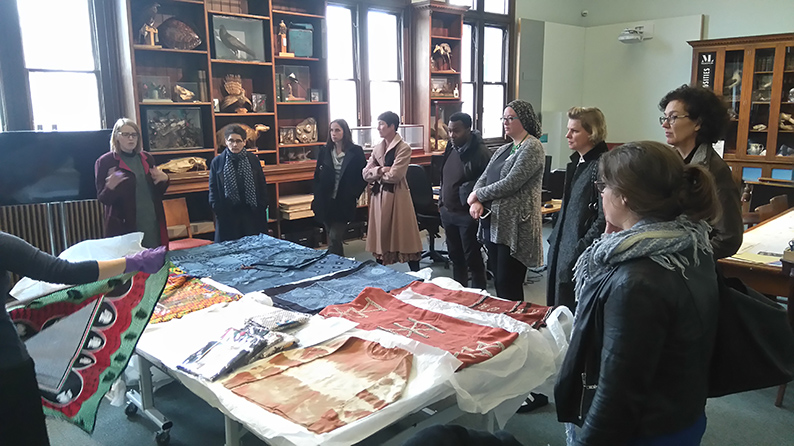In this post, Nicola Stylianou, a postdoctoral researcher at the Sussex Africa Centre and member of the Fashioning Africa collecting panel at Brighton Museum, discusses the context for the recent Creating African Fashion Histories conference, which she coordinated.
On 2 November 2016, Creating African Fashion Histories, a one day conference, was held at Brighton Museum as part of an extensive programme of events in support of the Fashion Cities Africa exhibition. The event was supported by the University of Brighton and the Sussex Africa Centre at Sussex University. The aim of the conference was to think about the current debates surrounding African fashion and also to consider the role of museum collections and exhibitions in these discussions. The involvement of the two local universities from an early stage was invaluable in terms of pooling knowledge and expertise; the University of Brighton has been central to the development of dress history as an academic discipline, while Sussex Africa Centre has strong links with Africa and a wealth of expertise in many aspects of African studies. The combining of different kinds of expertise in order to encourage new ways of thinking has been central to a number of projects relating to African fashion at Brighton Museum; the most visible of which has been the exhibition, which was curated by both the World Art Department and the Department of Costume and Textiles.
Fashion Cities Africa opened in April 2016 and will close on 8 January 2017. It is the first major UK exhibition devoted to contemporary African fashion so see it while you can! (Entry is free for students.) By focussing on specific individuals involved in fashion in four distinct African cities the exhibition avoids making lazy generalities about ‘Africa’. Instead it brings aspects of dress culture in Lagos, Johannesburg, Nairobi and Casablanca vividly to life. The exhibition is important not only for recognising the variety of fashion across the continent but also for showcasing contemporary designers, bloggers, photographers and stylists. The show is about these cities now; next year the story will be different. This is an unsurprising thing to say about fashion which is associated with a rapid turnover of styles, however, African clothing has all too often been seen in terms of unchanging textiles and ‘traditional’ garments which reflect the wearer’s ethnicity rather than their personal choices.
Museum collections have, to some extent, been guilty of perpetuating the stereotype of Africa as a place of unchanging tradition. They have contributed to this narrative by failing to collect contemporary material from Africa, which would allow them to effectively document change over time. Brighton Museum has an exceptional collection of historic textiles and dress from Africa, most notably weaving from West Africa collected in the late nineteenth or early twentieth century. However, very little material has been actively collected since the mid-twentieth century, a gap that is replicated across many UK collections. The museum is seeking to address this gap by creating a unique collection of African fashion from 1960 to 2006 as part of a Heritage Lottery Funded Collecting Cultures project. Like the exhibition, the Fashioning Africa project involves both staff from the world cultures department and the museum’s fashion curator. It is also innovative in another way; the curators handed over control of what was to be collected to an external panel, of which I was lucky enough to be a part. The collecting panel is formed of people with specialist knowledge in African dress, variously gained through academic training, through working in fashion and / or from personal experience. We were tasked, over 18 months, with deciding what should be in the collection. We discussed broad themes in the development of fashion in Africa that we wished to see represented in the collection, and in some cases suggested specific objects that reflected those themes. While we took the historic collection into consideration, we did not want to be bound by it as we felt this would limit the acquisitions. The first piece acquired was a T-shirt belonging to Charles Makhuya from Zimbabwe. He had acquired and hand-dyed the T-shirt in the 1970s when he was a freedom fighter with ZIPRA (the Zimbabwe People’s Revolutionary Army). The project is ongoing and we are currently waiting for the curators and some panel members to report back on how they are getting on with tracking down the desired objects. It is hoped that some of these pieces will be displayed in the museum as they are acquired.
There is plenty more work to be done to develop and disseminate understandings of African fashion history and the museum and universities are looking for ways to take this forward. Colleagues at University of Brighton are hoping to set up a funded research network about African fashion history, with a particular interest in the role museum collections and displays can play in creating understanding of the topic. We held a workshop (hosted by the Internationalising Design History Research Cluster) after the conference, in order to take advantage of the expertise present at the conference and to draw on the connections of our speakers to find individuals and organisations we could partner with. We are particularly interested in bringing scholars and practitioners working in Africa into the discussion. We also hope to produce a publication based on the papers given at the conference and are currently talking to a potential publisher. As I said, there is plenty still to do so do keep an eye out for further developments.
Caption
Conference participants view objects recently acquired by the Fashioning Africa project at Brighton Museum, November 2016. Royal Pavilion & Museums, Brighton & Hove. Photograph by Helen Mears.




Leave a Reply